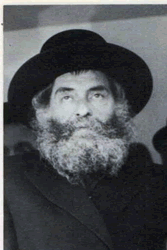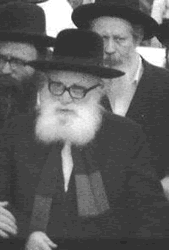Alter Family
Click on Photos to Enlarge
#alter-1
#alter-2
#alter-3
#alter-4
#alter-5
#alter-6:
#alter-7:
#alter-8
#alter-9
#alter-10
#alter-11
Yitzchak Meir Alter (also Rottenburg, Rothenburg or Rothenberg as an alternate for "Alter") (1799 – 10 March 1866), is considered to be the first Rebbe of the Ger Hasidic dynasty, which he founded in the town of Góra Kalwaria (known as "Ger" in Yiddish), Poland. He was also known as the Chidushei HaRim for his Torah books. He is sometimes referred to fondly as Reb Itche Meir by his followers.
Alter was born in Magnuszew, Poland, in late 1799. He came from a very distinguished family of rabbis, among the most prominent in Germany and Poland. He was a descendant of Rashi and of the Tosafist, Rabbi Meir ben Baruch of Rothenburg.
He married Feigele Lipszyc, daughter of Moshe 'Halfon' Lipszyc, in 1811, and settled in Warsaw. They had fourteen children (according to most published sources), most of whom died in infancy.
Alter became known as a Talmudic genius. At first he was close to the rebbes of Kozhnitz. After some years he was drawn to the Rebbe, Reb Simcha Bunim of Prshischa, whose close adherent he became. After the demise of the Rebbe, Reb Bunim, Alter became a disciple of Rabbi Menachem Mendel of Kotzk, known as the Kotzker Rebbe, who was famous for his acerbic wit and Talmudic brilliance. He was soon followed by a large number of Reb Bunim's followers. Alter and the Kotzer Rebbe eventually became brothers-in-law, when the latter married Chaya Lipszyc, the sister of Alter's wife Feigele.
Alter was succeeded as Rebbe by his colleague and disciple, Rabbi Chanoch Henoch of Alexander.
One of his sons, Avraham Mordechai, and three daughters, Cyna Pesia, Leah Hudes and Esther, survived to adulthood and married. By the time of Alter's death on 23 Adar 5626 (1866), only one child (Esther) remained alive.
--------------------
Yehudah Aryeh Leib Alter (1847–1905), also known by the title of his main work, the Sfas Emes, was a Hasidic rabbi who succeeded his grandfather, Rabbi Yitzchak Meir Alter, as the av beis din (head of the rabbinical court) and Rav of Góra Kalwaria, Poland (known in Yiddish as the town of Ger), and succeeded the Rebbe, Reb Heynekh of Alexander, as Rebbe of the Gerrer Hasidim.
He was born in 1847 and named Yehudah Leib; he was known to family and friends as Leybl. His father, Rabbi Avraham Mordechai Alter, died when Yehudah Leib was only eight years old, and his mother died before that. Orphaned of both parents, he was brought up by his grandparents, Rabbi Yitzchak Meir Alter (known as the Chiddushei Harim) and his wife. When he was about ten years old, his grandfather took him to visit the Kotzker Rebbe, an event which left a lifelong impression on him.
He married Yocheved Rivka, daughter of Reb Yidl (Yehuda) Kaminer. In order not to have the same name as his father-in-law, his own name was changed to Yehudah Aryeh Leib. He is said to have been attached to the name Yehudah, and was upset at not being able to use it as his name any longer.
When his grandfather, Rabbi Yitzchak Meir, died in 1866, many of the Hasidim sought to bestow the mantle of leadership upon eighteen-year-old Yehudah Aryeh Leib. He refused that position, and leadership of the Hasidim went to Rabbi Chanokh Heynekh HaKohen Levin of Aleksander. After the death of the latter in 1870, the Hasidim succeeded in gaining Yehudah Aryeh Leib's assent to become their Rebbe
During the Russo-Japanese War many of his young followers were drafted into the Russian Army and sent to the battlefields in Manchuria. The Rebbe was very worried over these devotees and would constantly write to them. His health suffered, and he died at the age of 57 on 11 January 1905 (5 Shevat 5665).
"When news of the Admor's petirah (funeral) spread, so many people rushed to Ger yesterday morning that although the railway dispatched extra trains there was hardly any space in the cars and thousands of people were still left without means to travel...
"One (tram)car with seating for 44 people held over 200, not even leaving any standing room, and in another car some people fainted as a result of the overcrowded conditions...
"When the time for tefillas Mincha arrived, all of the funeral-goers, 20,000 in number, stood in a field and davened Minchah together...
"The brief words spoken by the Rav of Sochachov made a powerful impression."[2]
Rabbi Yehudah Aryeh Leib was one of the greatest Torah scholars of his generation, teaching students such as Rabbi Nachman Shlomo Greenspan and many others. His output was prodigious, and his works (all entitled Sfas Emes) deal with the legalistic Talmud, the ethics of Midrash, and mysticism of the Zohar.
His Torah homilies as delivered to his Hasidim, and arranged according to the weekly parashah and the festivals, were the first to be published posthumously under the name Sfas Emes. The title was taken from the closing words of the final piece he wrote (Sfas Emes, Vayechi 5665). His chiddushim (original Torah thoughts) on many Talmudic tractates, and on Yoreh De'ah, have been published under the same name.
The Sochatchover Rebbe, Rabbi Avrohom Bornsztain (known as the Avnei Nezer), a leading Torah scholar and posek in his own right, is said to have maintained two bookcases — one for Rishonim (earlier commentators) and another for Acharonim (later commentators). The volumes of the Sfas Emes, written in the late 1800s, were to be found in his bookcase containing the Rishonim. To study some portions of the Talmud without the Sfas Emes is unthinkable to the modern-day scholar.[3] The Rebbe of Tzaltz wrote a super-commentary to the Sfas Emes entitled the Sfas Bitz.
The Sfas Emes Yeshiva in Jerusalem is named after him and includes his teachings in the curriculum.
He was succeeded as Gerrer Rebbe by his son, Rabbi Avraham Mordechai Alter.
Yehudah Aryeh Leib Alter
Gerrer Rebbe
Term 1870 – 11 January 1905
Full name Yehudah Aryeh Leib Alter
Main work Sfas Emes
Born 15 April 1847
Warsaw
Buried Ger
Dynasty Ger
Predecessor Chanoch Heynekh of Aleksander
Successor Avraham Mordechai Alter
Father Avraham Mordechai Alter (I)
Mother Ester Landsztajn
Wife1 Yocheved Rivka Kaminer
Children1 Avraham Mordechai Alter
Yitzchak Meir Alter
Moshe Betzalel Alter
Chanokh Chayim Alter
Feyge Lewin
Yisrael Alter
Nechemya Alter
Menachem Mendel Alter
Noach Alter
Esther Biderman
Wife 2 Reyzl Halberstam
Avraham Mordechai Alter (25 December 1866 – 3 June 1948), also known as the Imrei Emes after the works he authored, was the third Rebbe of the Hasidic dynasty of Ger, a position he held from 1905 until his death in 1948. He was one of the founders of the Agudas Israel in Poland and was influential in establishing a network of Jewish schools there. It is claimed that at one stage he led over 200,000 Hasidim.
He had eight children by his first wife, Chaya Ruda Czarna, daughter of Noach Czarny, a prominent Gerrer Hasid in Biala. His eldest son, Rabbi Meir Alter, who was a Torah scholar and businessman, perished in Treblinka during the Holocaust with his children and grandchildren. His second son, Rabbi Yitzchak Alter, died in 5695 (1934) in Poland.
In 1922, his wife Chaya Ruda died. Some time later he married his niece, Feyge Mintshe Biderman, who bore him his youngest child, Pinchas Menachem Alter, in 1926.
In 1924, Rabbi Avraham Mordechai visited Palestine together with his brother in-law, Rabbi Hirsh Heynekh Lewin, his son-in-law Rabbi Yitzchak Meir Alter and the Sokolover Rebbe, Rabbi Yitzchak Zelig Morgensztern. Over a six-week period, they visited Jerusalem, Safed, Hebron, Tiberias and Tel Aviv.[1]
During World War II, Rabbi Avraham Mordechai was a prime target of the Nazi authorities in German occupied Poland.
He managed to escape to Palestine in 1940 with several of his sons and began to slowly rebuild his Hasidic dynasty.
With the outbreak of the 1948 Arab-Israeli War he was trapped in Jerusalem. He died during the holiday of Shavuot of natural causes during the siege of the city by the Jordanian Arab Legion. As bodies could not be removed to the Mount of Olives during wartime, he was buried in the courtyard of the Sfas Emes Yeshiva, located near the Mahane Yehuda Market in downtown Jerusalem.
After his death, the dynasty continued with his three remaining sons, who became the consecutive next three heads of the Gerrer Hasidim worldwide: Rabbi Yisrael Alter (fourth rebbe of Ger); Rabbi Simchah Bunim Alter (fifth rebbe of Ger); and Rabbi Pinchas Menachem Alter (sixth rebbe of Ger). In 1996, Rabbi Pinchas Menachem Alter was buried next to his father in the courtyard and an ohel was placed over both graves, which are visited regularly by students in the adjoining yeshiva.


